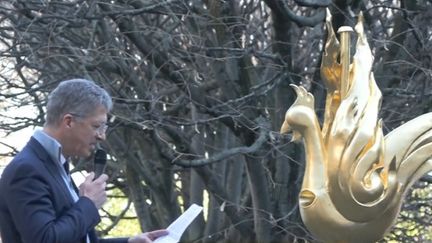Designed by the chief architect of historic monuments Philippe Villeneuve, the famous rooster will sit 96 m above the ground.
Published
Update
Reading time: 2 min

Back. An emblematic element of Notre-Dame, its rooster must regain its place in the sky of Paris, on the afternoon of Saturday December 16, marking a new major milestone less than a year before the planned reopening of the cathedral.
The previous rooster having been too damaged during the fire which ravaged the monument in 2019. A new one, designed by the chief architect of historical monuments Philippe Villeneuve, was built and will be blessed on the ground by the Archbishop of Paris , Monsignor Laurent Ulrich, before being craned to the top of the spire, 96 meters above the ground.
It will contain relics saved from the fire, precious to Catholics. In this case, it is a fragment of Christ’s crown of thorns, the bones of Saint-Denys, first bishop of Paris in the 3rd century, and the bones of Sainte-Geneviève, patron saint of the city of Paris died around the year 500. Another sealed tube will be placed in the rooster, showing the names of all the people who took part in the reconstruction, i.e. nearly 2 000.
A new rooster for Notre-Dame de Paris
It will be installed in the afternoon of Saturday December 15, 2023 – (FRANCEINFO)
Notre-Dame is gradually regaining its emblems
On December 8, President Emmanuel Macron visited the construction site, one year to the day before the planned reopening of the cathedral, to which he intends to invite Pope Francis. It was notably announced that the former rooster was going to take his place in “a museum of the work of Notre-Dame de Paris”which must see the light of day “in the premises of the Hôtel-Dieu”nearby on the Île de la Cité.
A spectacular fire ravaged the cathedral on April 15, 2019, whose spire, designed by the 19th century architect Eugène Viollet-le-Duc, collapsed, sparking global emotion. The new spire, still corseted by a forest of scaffolding, has reappeared in the sky of Paris, topped since December 6 with its cross.
A few days earlier, the head of reconstruction, Philippe Jost, who succeeded General Jean-Louis Georgelin after his sudden death this summer, had indicated that once the spire had reached 96 meters, the stage of “the lead blanket” For “that the scaffolding, which largely hides the spire, can come down”.
